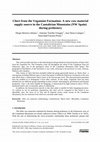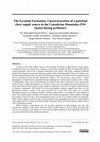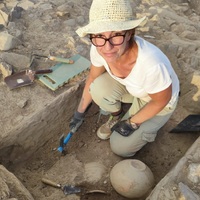Papers by Diego Herrero

Journal of Archaeological Science: Reports, 2020
This paper presents an update of the known data on the lithic industries of the “Mesolithic with ... more This paper presents an update of the known data on the lithic industries of the “Mesolithic with geometrics”. From the information available in two caves, La Uña and El Espertín (León, Spain), located south of the Picos de Europa (in the central sector of the Cantabrian Mountains), the results of the different methodological approaches are presented: the raw materials used and the sources of supply of chert and flint, the main chaînes operatoires and their relationship with the raw materials and the relationship of the latter with the retouched industry. Finally, using local and regional outcrops, we propose the possible routes travelled by the human groups that occupied these caves between the north and the south of the Cantabrian Mountains.
Proximate local raw materials (less than 15 km) were exploited most, but some distant local types (15–30 km) were also directly acquired. Non local raw materials are significantly more frequent in La Uña than in El Espertín. Nevertheless, in both caves there are regional (30–120 km) and tracer (>120 km) chert and flint varieties that prove the connection between the south of the Cantabrian Mountains and the north (northwest and northeast), involving the coastal area in these relationships. The technological management of theses raw materials suggests some sort of planning in their territory wide procurement.
Apart from more flexible modalities for the production of blade and bladelets, good quality laminar blanks were obtained by pyramidal and prismatic unipolar modalities in chert and flint raw materials from local and regional lithologies. More diverse chains were applied to produce flakes, especially in local raw materials (and with a greater variability in El Espertín).

Álvarez Fernández, A. et al. (orgs.): Los tiempos cambian, de la piedra al teclado. X Jornadas de Jóvenes en Investigación Arqueológica, Burgos 7-10 Junio 2017. AHA (Asociación de Historia y Arqueología de Burgos). Burgos, 2019
El estudio del registro lítico cuenta con una amplia trayectoria científica desde los inicios de ... more El estudio del registro lítico cuenta con una amplia trayectoria científica desde los inicios de la disciplina prehistórica, sin dejar de evolucionar tanto a nivel teórico como práctico, constituyendo en la actualidad uno de los pilares fundamentales para la secuenciación sistemática de las culturas arqueológicas y la reconstrucción de las actividades socio-económico-culturales de los grupos humanos del pasado. Las diferentes metodologías implicadas en su investigación han proliferado durante las últimas décadas, aunque no siempre de una manera coordinada. Desde una perspectiva dialéctica que reivindique el papel activo de la materialidad de las sociedades prehistóricas, abogamos por una visión de los artefactos líticos como sujetos inmersos en las redes sociales de sus productores, y por lo tanto dotados de una “biografía” propia y una trayectoria “vital” rastreable arqueológicamente, en la que entran en juego diferentes influencias, desde su naturaleza petrológica como materia prima en bruto, hasta su abandono en contextos antrópicos y sus consecuentes alteraciones postdeposicionales. Por ello, este espacio de debate que transcribimos aquí pretende integrar las diferentes aproximaciones metodológicas relativas a las industrias de origen lítico, estructurado en cinco fases: una primera, geológica, con estudios arqueopetrológicos y de aprovisionamiento; una segunda, tecnológica, tipológica y morfométrica; una tercera, de uso, donde se enmarquen los estudios traceológicos y de residuos; una cuarta, la cognitiva, fundamentada en los estudios etnoarqueológicos y experimentales; y finalmente, una quinta, tafonómica, reservada a los estudios de alteraciones postdeposicionales en objetos líticos.
The “black chert” is a fine-grained dark colour siliceous rock that crops out in the Cantabrian Z... more The “black chert” is a fine-grained dark colour siliceous rock that crops out in the Cantabrian Zone (Palaeozoic Era) a part of the Cantabrian Mountains (in the North of Spain). This group of raw materials have been considered unitarily in the archaeological studies. However, this variety of chert proceeds from numerous geological formations along the whole Cantabrian Zone, each with its own characteristics. The “black chert” has several problems of identification and nomenclature that are necessary to know to make a more unitary work in the Cantabrian Mountains. In spite of these differences with other cherts from other geographical areas, it has been an essential resource for prehistoric groups who inhabited the Cantabrian Mountains and its basins.

This work provides the keys to the mineralogical and geochemical characterization of black chert ... more This work provides the keys to the mineralogical and geochemical characterization of black chert from the Vegamián Fm. This formation crops out throughout the whole of the Cantabrian Zone (of Palaeozoic age), one of the geological zones of the Cantabrian Mountains (NW Spain). The geographical distribution of this formation is very wide, surfacing in the provinces of León, Asturias, Palencia and Cantabria. This variety of chert had been included within the group generically known as 'black chert', a macrogroup including different types of chert that appear in different Palaeozoic formations in the area and which share a characteristic black colour at the macroscopic level. The characterisation presented here has enabled us to distinguish it from other varieties. In this study, Vegamián chert has been divided into two different groups depending on their textural, mineralogical, geochemical and thermal propierties. Type 1, the most suitable for knapping, is characterized by high content in silica (>97%), laminated matrix and, occasionally, ghost of radiolarians. In addition, the characteristics specific to this chert make it suitable for lithic knapping processes. To confirm its use by prehistoric populations, this chert will be compared to that found in two Mesolithic sites, the caves of La Uña and El Espertín (León, south versant of the Cantabrian Mountains), the raw materials from which are currently under study.

Journal of Lithic Studies, 2016
A study of the chert nodules found in the Escalada Formation (Carboniferous, Ponga region, Cantab... more A study of the chert nodules found in the Escalada Formation (Carboniferous, Ponga region, Cantabrian Zone) was carried out as a means to characterise a number of lithic raw materials found in several prehistoric sites of the Cantabrian Mountains (NW Spain). This study comprises fieldwork aimed at locating the outcrops and obtaining samples. Some selected samples from two localities were used for both petrological (macroscopic and microscopic analyses from thin sections) and geochemical (X-ray fluorescence and powder diffraction) analysis. The macroscopic study shows a rather homogeneus coloration and a conchoidal fracture although two extreme types of cherts with a variety of intermediate forms can be differentiated according to the matrix composition. The microscopic analysis shows a high heterogeneity in carbonate versus silica percentage and gentle differences in some other features such as type of silica, origin of carbonates, occurrence of organic matter and type of skeletal components. The results of several geochemical analysis suggest that there are not geochemical features neither in the major elements nor in the traces that allows us to clearly distinguish between the analysed samples. All these studies allow us to define the main features of these chert nodules and to establish several types and varieties among them. Those varieties with high percentage of silica and with a more homogeneous matrix are the most suitable samples for knapping. These results together with the study of the geological and geographical location of archaeological sites suggest that the nodules from the Escalada Formation likely were lithic material supply sources used in knapping activities
When aiming to demonstrate the use of these materials at archaeological sites the sole macroscopic analysis of the pieces does not suffice; further analyses, such as those involving thin sections, are necessary. The absence of chert from Escalada Formation in some Mesolithic sites in the area was confirmed via these additional analyses.

This study presents the main features of the lithic industry we have termed ‘Mesolithic with geom... more This study presents the main features of the lithic industry we have termed ‘Mesolithic with geometrics’. It has been observed at two cave sites, El Espertín and La Uña (levels III and IV), both located on the southern versant of the Cantabrian Range, and with chronologies ranging from the second half of the 7th millennium cal. BC to the end of the 6th millennium cal. BC. This work will focus on the characterization of the raw materials and the evaluation of their sourcing patterns. Also, a techno-typological study of the lithics, focusing on the retouched tools, will be presented. The two caves show a number of similarities, such as their altitude (more than 1200 m.a.s.l. in both cases) and their small size. As for the lithics, the raw materials used and the scarcity of geometrics are much the same, and they also share a lithic industry with deeply-rooted archaic features linked to the Upper-Palaeolithc/Azilian regional tradition.
Férvedes, 8: 45-54, 2015
This study presents a re-analysis of the available data on the use of the group of raw materials ... more This study presents a re-analysis of the available data on the use of the group of raw materials categorised generally as ‘flint’ in archaeological research, and which were used for lithic knapping throughout prehistory in this area of the Duero River basin. This group comprises flint or chert itself and radiolarites, as well as some slate sensu lato. A geological assessment is undertaken as part of this study with the aim of pinpointing the areas where these various raw materials were procured. The review of their presence within archaeological contexts will enable us to gain a better understanding of the kinds of raw-material management strategies in place in the Meseta throughout prehistory.
El yacimiento arqueológico de La Uña (Acebedo, León) (Figura1) se encuentra en un afloramiento ca... more El yacimiento arqueológico de La Uña (Acebedo, León) (Figura1) se encuentra en un afloramiento calizo cerca del pueblo epónimo, a 1200 metros sobre el nivel del mar y con la boca de la cueva orientada al sur. Está situado en la intersección de dos valles que terminan en puertos de montaña, por los que el contacto con la vertiente norte de la cordillera cantábrica es de menor dificultad. A los pies de la cueva discurre un pequeño arroyo, afluente del río Esla por la izquierda, que ha formado un conjunto de terrazas fluviales superpuestas. Una de estas terrazas está a la salida de la cueva, lo que hace pensar que pudo ayudar a ampliar el hábitat de la cavidad, que es de pequeñas dimensiones, unos 35m 2 (Neira et al., 1997).
Congress Presentations by Diego Herrero










Uploads
Papers by Diego Herrero
Proximate local raw materials (less than 15 km) were exploited most, but some distant local types (15–30 km) were also directly acquired. Non local raw materials are significantly more frequent in La Uña than in El Espertín. Nevertheless, in both caves there are regional (30–120 km) and tracer (>120 km) chert and flint varieties that prove the connection between the south of the Cantabrian Mountains and the north (northwest and northeast), involving the coastal area in these relationships. The technological management of theses raw materials suggests some sort of planning in their territory wide procurement.
Apart from more flexible modalities for the production of blade and bladelets, good quality laminar blanks were obtained by pyramidal and prismatic unipolar modalities in chert and flint raw materials from local and regional lithologies. More diverse chains were applied to produce flakes, especially in local raw materials (and with a greater variability in El Espertín).
When aiming to demonstrate the use of these materials at archaeological sites the sole macroscopic analysis of the pieces does not suffice; further analyses, such as those involving thin sections, are necessary. The absence of chert from Escalada Formation in some Mesolithic sites in the area was confirmed via these additional analyses.
Congress Presentations by Diego Herrero
Proximate local raw materials (less than 15 km) were exploited most, but some distant local types (15–30 km) were also directly acquired. Non local raw materials are significantly more frequent in La Uña than in El Espertín. Nevertheless, in both caves there are regional (30–120 km) and tracer (>120 km) chert and flint varieties that prove the connection between the south of the Cantabrian Mountains and the north (northwest and northeast), involving the coastal area in these relationships. The technological management of theses raw materials suggests some sort of planning in their territory wide procurement.
Apart from more flexible modalities for the production of blade and bladelets, good quality laminar blanks were obtained by pyramidal and prismatic unipolar modalities in chert and flint raw materials from local and regional lithologies. More diverse chains were applied to produce flakes, especially in local raw materials (and with a greater variability in El Espertín).
When aiming to demonstrate the use of these materials at archaeological sites the sole macroscopic analysis of the pieces does not suffice; further analyses, such as those involving thin sections, are necessary. The absence of chert from Escalada Formation in some Mesolithic sites in the area was confirmed via these additional analyses.